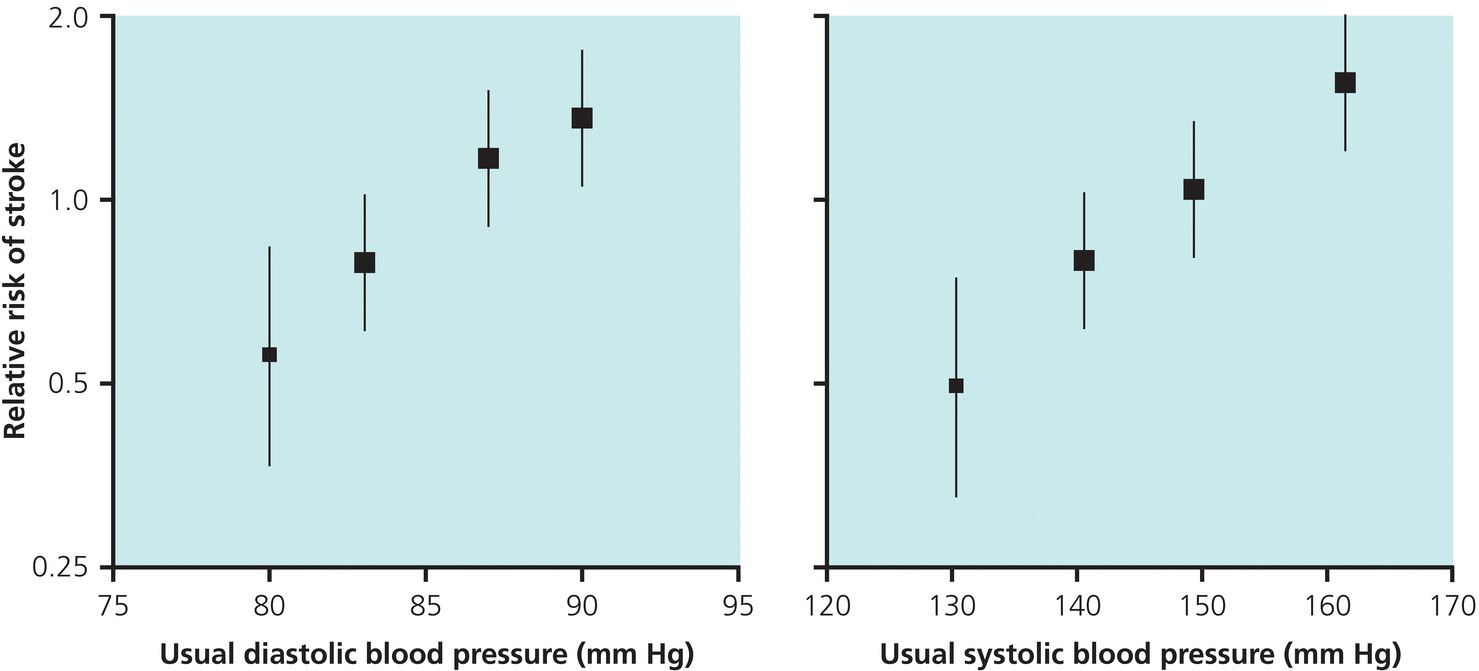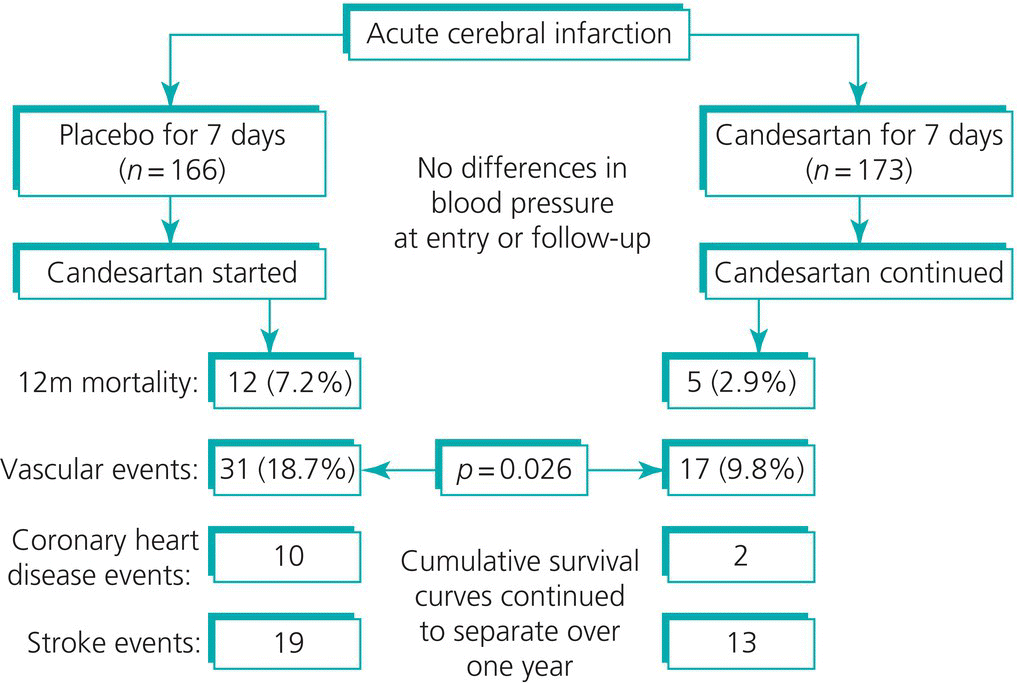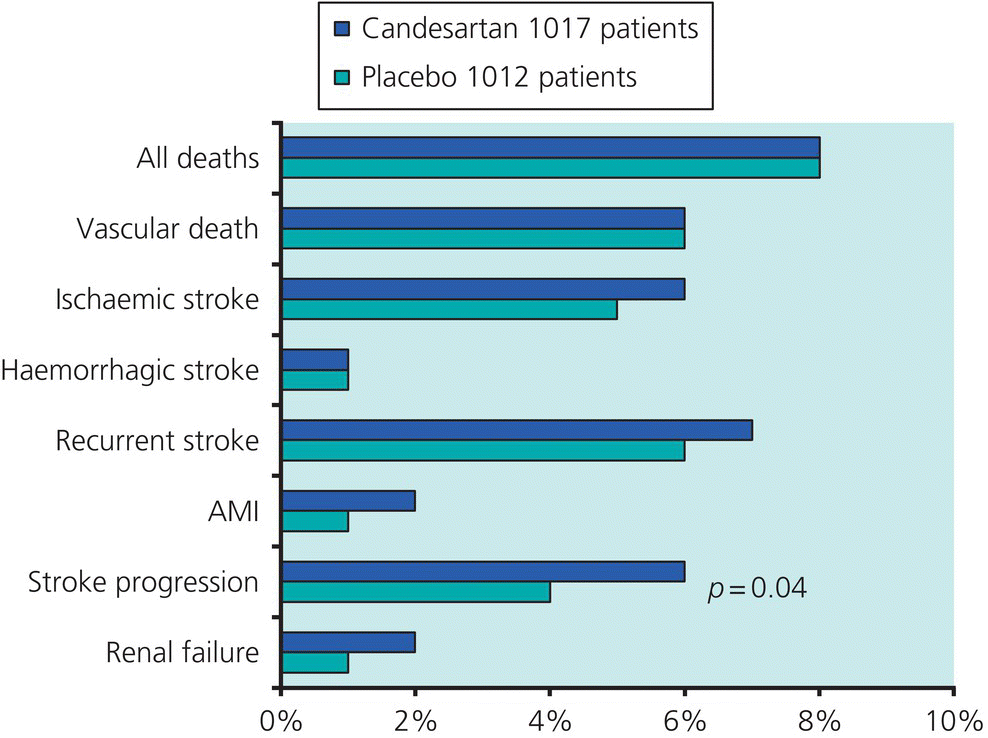Chapter 10 The presence of ‘co-morbidities’ and previous cardiovascular diseases substantially influences the methods of assessing patients with hypertension, the management of high blood pressure and the most appropriate antihypertensive drugs. As with all patients, total cardiovascular risk rather than just the height of the blood pressure must be taken into account. As mentioned in Chapter 1, hypertension is the most important treatable risk factor for stroke, and antihypertensive treatment significantly reduces this risk. Half of all patients with stroke will have a history of hypertension, and up to 40% of patients are taking antihypertensive treatment when their stroke occurs. Immediately after a stroke, a breakdown in cerebral autoregulation occurs. As a result, rapid decreases in blood pressure can cause a reduction in cerebral perfusion and a further extension of the stroke. For this reason, most authorities recommend that antihypertensive drugs should be withheld until the patient is ambulant; however, very little trial data is available on this point. In the acute period after a stroke, casual levels of blood pressure are often high, with about 70% of patients having levels ≥140/90 mm Hg within the first 48 h of ictus. These levels usually subside over the next 10–14 days. In part, the increase may be simply the result of the stress of the stroke and of hospitalisation, but other mechanisms may also be responsible, including pre-existing hypertension and neurohumeral activation. The higher the blood pressure at presentation, the worse the outcome, although patients who are hypotensive also do badly. The international stroke trial reported a J-shaped relation between initial blood pressure and outcome, with early deaths increasing by 18% for every 10 mm Hg of admission systolic blood pressure below 150 mm Hg and by 4% for every 10 mm Hg above 150 mm Hg. On a longer-term basis, in stroke survivors, there is a much closer relationship between the height of the blood pressure (Figure 10.1). Figure 10.1 Stroke recurrence rate following a minor stroke or a transient ischaemic attack (TIA) in relation to usual blood pressure in 2435 patients attending 23 centres in New Zealand and Scotland. Source: Reproduced with permission from Rodgers, A., et al. (1996) BMJ, 313, 147. © BMJ Publishing Group Ltd. The value of blood pressure reduction in patients immediately following their stroke is controversial and there are wide international differences in clinical practice. Some studies of β blockers and calcium blockers used immediately after a stroke have shown no benefit, but these studies were small. It is possible that any benefits of blood pressure reduction were offset by harmful reductions in cerebral blood flow. There is some evidence that the angiotensin blocking drugs (ACE inhibitors and ARBs) do not have adverse effects on cerebral blood flow immediately following a stroke, unlike the other antihypertensive drugs. The acute candesartan therapy in stroke survivors (ACCESS) trial suggested that the ARB, candesartan may be of benefit in patients with high blood pressure (200/110 mm Hg) within the first 48 h after cerebral infarction (Figure 10.2). Figure 10.2 Results of the acute candesartan cilexetil therapy in stroke survivors. Source: . Data from Schrader, J., et al. (2003) Stroke, 34, 1699–1703 The results of the ACCESS trial are offset by the larger SCAST trial, which reported adverse outcomes with candesartan versus placebo in 2029 stroke patients (Figure 10.3).The SCAST investigators also included a meta-analysis in their paper of all the trials of blood pressure reduction following an acute stroke. Their conclusion was that there was a non-significant trend for acute blood pressure reduction to be harmful. The treatment to reduce blood pressure in acute stroke (<48 h) is probably only appropriate when blood pressure is persistently very high (>220/110 mm Hg), although no robust outcome data from clinical trials are available on this point. Figure 10.3 A comparison of candesartan versus placebo on outcome following acute stroke. Only the adverse effects of candesartan on stroke progression were statistically significant. Source: Data from Sandset, E.C., et al. (2011) Lancet, 377, 741–750. There is now good evidence that intravenous thrombolysis with tissue plasminogen activators (TPA) does improve outcomes in patients with acute cerebral infarction, but this is only feasible if computed tomography or magnetic resonance imaging of the head is available within 2 h of stroke onset. If thrombolysis is given, then antihypertensive drugs – such as labetolol, nifedipine or intravenous sodium nitroprusside – will be needed if blood pressure is very high. Immediate reductions in blood pressure may also be beneficial in patients with proven cerebral haemorrhage, although there is little information on this point. High blood pressures that persist for more than a month after a stroke are associated with an increased risk of recurrence, as well as the subsequent development of cardiovascular events. Data from seven randomised controlled intervention trials of reductions in blood pressure in patients with stroke or transient ischaemic attacks who were not necessarily hypertensive have shown that treatment significantly reduces the odds ratio for recurrence of fatal and non-fatal stroke by 26% and the odds ratio for cardiovascular events by 16%. The perindopril protection against recurrent stroke study (PROGRESS) is the largest study to assess the effects of reductions in blood pressure (using the ACE inhibitor, perindopril with or without the thiazide like diuretic, indapamide) on recurrence in patients with a history of stroke or transient ischaemic attack with or without hypertension (Table 10.1). This trial was confined to survivors of stroke seen in follow-up clinics and provides no information on the management of acute stroke. A post-hoc subgroup analysis of this trial suggested that the benefits of treatment were confined to patients who received perindopril with indapamine but not those who received perindopril alone. These findings, however, are controversial. Table 10.1 Results of the PROGRESS trial of perindopril/indapamide versus placebo in stroke survivors Patients who have had a transient ischaemic attack or cerebral infarct should receive aspirin (75–300 mg/day). This will reduce the risk of subsequent cardiovascular events by about 11% after acute stroke and by 20% in those with a past history of ischaemic stroke. Aspirin should, however, only be administered once the blood pressure has been controlled. For patients with AF, anticoagulation will reduce the incidence of a further stroke by >65%, and treatment with statins reduces the risk of subsequent major vascular events by >20%. In patients with symptomatic severe carotid artery stenosis (≥70% but without near occlusion), carotid endarterectomy reduces subsequent stroke by 40%.
Hypertension in patients with cardiovascular disease
Introduction
Hypertension after stroke

Blood pressure reduction in acute strokes


Blood pressure reduction after complete or partial recovery from a stroke
Active
n = 3051
Placebo
n = 3054
Percent reduction
(95% CI)
All second strokes
307
420
28% (17–38)
ischaemic stroke
246
319
24% (10–35)
haemorrhagic stroke
37
74
50% (26–67)
Acute myocardial infarction
115
154
26% (6–42)
Hypertension in patients with cardiovascular disease
Source: Data from PROGRESS Collaborative Group. Lancet 2011; 358: 1033–1041.
Only gold members can continue reading. Log In or Register to continue

Full access? Get Clinical Tree


